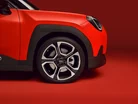The Evolution of Vehicle Attributes in the Electric Age

Vehicle attribute engineering is the subjective process that results in, for example, a BMW 'feeling' different to driving a Ford or Nissan.
Jon Maybin, Senior Vehicle Attribute Engineer at HORIBA MIRA, leads EV attribute projects and explores how attribute engineering will evolve, using experienced test drivers and cutting-edge simulators. This is particularly challenging for EVs, as they:
- Carry higher unladen kerb weights
- Deliver torque in a instant fashion
- Make little noise in comparison to ICE vehicles.
Here, he tells us more.
The evolution of vehicle attributes as EVs take off
According to John, driven vehicles with high levels of autonomy, or autonomous pods, will change the attribute hierarchy where more focus is given to ride comfort, disturbances and refinement over steering feel, handling behaviour and platform response.
At the same time, however, the requirement for a vehicle to be consistent, predictable, stable and behave in a linear way, will arguably be increased as the autonomous stack will need to be able to control the vehicle in all scenarios in a repeatable and controlled manner to, for instance, avoid lateral and longitudinal jerk caused by road surface imperfections.
“Well-engineered chassis systems and the right attribute development methodology will continue to be required to produce the products end consumers demand, in the face of the ever-changing mobility landscape,” says Jon. “Attribute engineering is a well-established specialism of automotive engineering that imbues cars (as well as marques more generally) with distinct personality.”
Consistent with any form of product USPs, these attributes are essential to build brand personality and customer loyalty. Attribute engineering spans a wide range of subjective considerations that create a different driving experience behind the wheel of an agile-handling performance car compared to the smooth ride and handling of a luxury segment sedan.
However, this engineering discipline is now responding to a huge shift as cars electrify.
The impact of the EV transition on brands
Traditional internal combustion engines have had a disproportionately influential effect on the key items in the attribute engineer’s toolkit from driving dynamics, performance and drivability to noise, vibration and harshness. In some quarters, there is a view that the substitution of endlessly variable combustion engines with ubiquitous electric motors has eroded the EV driver’s sense of brand.
“Not only has the most significant influence on brand characteristics been removed, but in the immediate transition to battery electric vehicles, consumers have also increased their demand for connectivity and functionality which in turn has reduced the amount of development time available for the complex process of optimising vehicle attribute factors,” Jon continues. “Attribute engineers at HORIBA MIRA are at the forefront of refining subjective engineering processes to contend with the new challenges that electric vehicles present to reinstate a distinct sense of ‘brand’ with the motorist.”
As this work is underway, HORIBA MIRA attribute engineers also have an eye that increasing levels of driver automation are likely to have on the customer.
“After all, relinquishing control of parts of the driving process will not necessarily provide engineers with a reduced canvas upon which to communicate the distinctiveness of a particular driving experience,” he says.
******
Make sure you check out the latest edition of EV Magazine and also sign up to our global conference series - Sustainability LIVE 2024.
*******************
EV is a BizClik brand.

